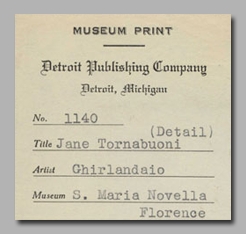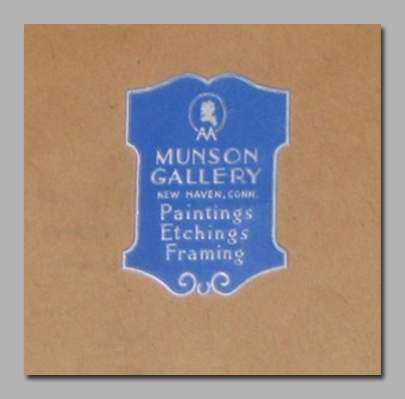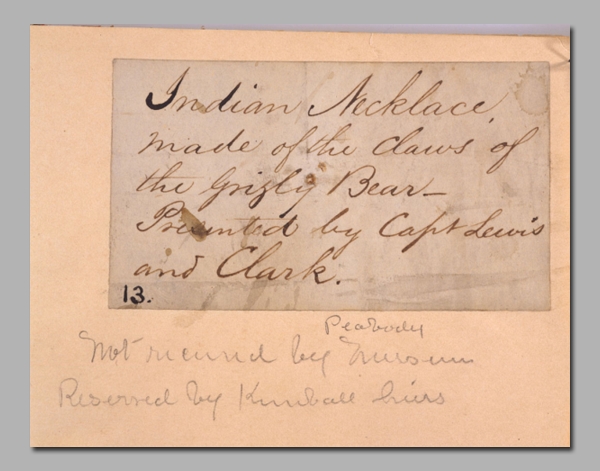FORENSIC LABELS
When you turn over your painting, it’s very likely that you see a label, stamp, or other identifier. Art Experts has investigated such labels for many year, and has had enormous success in finding direct links between such labels and the client’s painting. We know how to track down the right information to verify the history of your painting.
Print label
GALLERY LABELS
In the past 200 years, many galleries glued a label on the verso of the paintings they handled, generally on the stretcher.
These labels provide the name of the gallery and sometimes the address. Even if the label is partially torn, as is so often the case, some little bit of information generally remains, such as part of the name or a street.
With research and patience, it is often possible to determine when and where the gallery was in business. City Halls, Chambers of Commerce, tax collector offices, and local historic archives, generally have records on all the businesses who ever existed in a town, provided the archives were not destroyed during fires, floods, revolutions, wars or bombardments.
Munson Gallery label
This provides a date and a location for the painting and helps in reconstructing its history of ownership, its provenance, and it confirms that it existed at a known date in the past.
Additionally, because galleries generally operate by representing specific artists, or specializing in art of particular areas and periods, these labels create a presumption that the painting is probably authentic, if the artist is one the gallery is known to have been associated with.
Sometimes, for paintings that are not very old, the gallery is still in existence, and confirmation can be obtained that they represented the artist and that the painting is authentic.
Last year, we were researching an unknown painting in the collection of a major corporation, and it seemed to be the work of American artist, David Johnson 1827-1908. An important artist. Part of a label remained on the back, and we eventually made out the name Bonfoey. A bit of research revealed a Bonfoey Company in Cleveland, Ohio, and they were still in business.
They were kind to go to their archives and confirmed that many years ago they had handled a David Johnson painting. In fact, according to their records, the transaction had involved TWO David Johnsons. We told our client, and they launched a company wide search through their numerous office buildings. Luckily, they located the second David Johnson. The two paintings were reunited and authenticated.
AUCTION LABELS
Another type of label found on the back of paintings is auction lot numbers. Many of these only have a number. The name and location of the auction house is generally not printed, except for labels of the past few decades. In this case, with some research through auction sales catalogues, it is sometimes possible to match the lot number to the auction sale of the painting. Then, the description in the catalogue provides information about the painting and can be very determining in establishing authenticity.
Even older labels, without auction names, provide some information. Some are printed, some are inscribed in pencil, and others are in ink. The style and type of the writing give an idea of when and where they were used because handwriting was different in such places as the US, Germany or France. The simple abbreviation for the word “number” can provide a clue, for example, “No” or “no” are English, “no.” and “N°” are French, “n.” is Italian, and “Nr.” is German, etc. Standards of abbreviation are not always respected, and they change over time, but one deduction or one hint, combined with other pieces of information, frequently leads to something.
The general appearance of the paper also provides some information regarding date and location. For example, deep red labels were popular with British auction houses until about 1920. The French used rectangular white labels with blue lines.
EXHIBITION AND TRAVELING EXHIBITION LABELS
The situation for these type of labels is the same as for gallery labels. Few show an exhibition name, location, or additional information. Deductions and conclusions have to be drawn from the paper and type of writing or printing. If the exhibition name is printed, then it is just a matter of looking up the lot number in exhibition records, provided they exist. They do exist for the important exhibitions in the US, the UK, and for the past 200 to 250 years in Continental Europe and in Continental Europe of the past 200 to 250 years.
In some cases, artists used their own exhibition labels, either with a full name or initials. This greatly simplifies the authentication process.
MUSEUM LABELS
Some museums pasted a label on the back of paintings. Their name is generally printed. The procedure is then simple, research the museum archives and old inventory records for information on the painting and probably the name of the painter.
In the past 200 years, many galleries glued a label on the verso of the paintings they handled, generally on the stretcher.
These labels provide the name of the gallery and sometimes the address. Even if the label is partially torn, as is so often the case, some little bit of information generally remains, such as part of the name or a street.
A label from the Peale Museum
With research and patience, it is often possible to determine when and where the gallery was in business. City Halls, Chambers of Commerce, tax collector offices, and local historic archives, generally have records on all the businesses who ever existed in a town, provided the archives were not destroyed during fires, floods, revolutions, wars or bombardments.
This provides a date and a location for the painting and helps in reconstructing its history of ownership, its provenance, and it confirms that it existed at a known date in the past.
Additionally, because galleries generally operate by representing specific artists, or specializing in art of particular areas and periods, these labels create a presumption that the painting is probably authentic, if the artist is one the gallery is known to have been associated with.
Sometimes, for paintings that are not very old, the gallery is still in existence, and confirmation can be obtained that they represented the artist and that the painting is authentic.
Last year, we were researching an unknown painting in the collection of a major corporation, and it seemed to be the work of American artist, David Johnson 1827-1908. An important artist. Part of a label remained on the back, and we eventually made out the name Bonfoey. A bit of research revealed a Bonfoey Company in Cleveland, Ohio, and they were still in business.
They were kind to go to their archives and confirmed that many years ago they had handled a David Johnson painting. In fact, according to their records, the transaction had involved TWO David Johnsons. We told our client, and they launched a company wide search through their numerous office buildings. Luckily, they located the second David Johnson. The two paintings were reunited and authenticated.
Art Experts finds successful solutions to our client’s questions, about where their paintings came from, and how that affects authenticity or attribution. We look forward to helping you with your painting and discussing it with you. Please contact us at info@artexpertswebsite.com.



